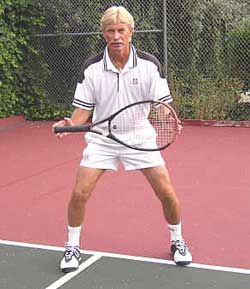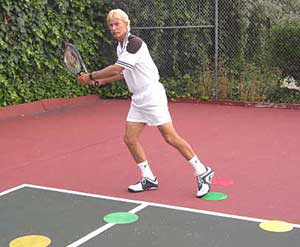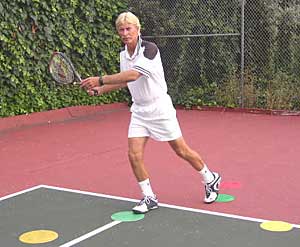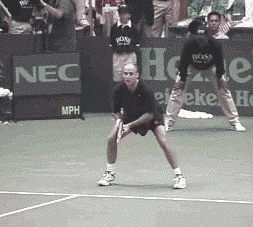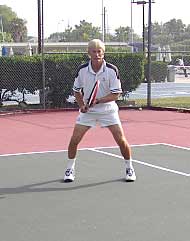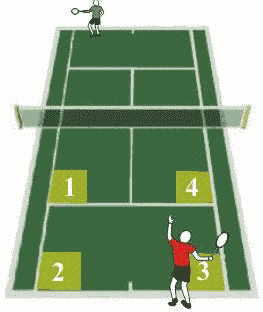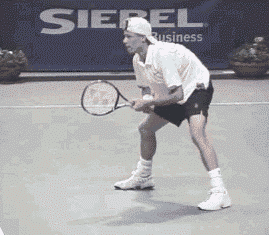|
TennisOne Lessons
When I teach club players the return of serve, I start with the basics, which means the ready position. Players are often told, ďyour feet should be wider than your shoulders,Ē but Iíve found they donít lower their center of gravity low enough or spread their legs wide enough. Start with your feet spread wider than a racquetís length. This is the All-Sports stance. You see it in a basketball player playing defense or a linebacker in football, ready to move in any direction to stop a runner. As the server begins the motion to serve, the receiver should shuffle from side to side, perhaps rhythmically swaying the shoulders a bit to create a loose, ready feeling. This helps prepare the mind and body for a quick step and shoulder turn. Itís best to be in motion, so you can move explosively to the serve. And, as Tony Robbins says, "motion creates emotion." That is, motion helps create positive emotions to offset the nerves players often experience when waiting for the serve. As the server tosses the ball, the receiver should be moving forward. If the serve is fast, the receiver doesnít have enough time to take a full backswing, and the forward momentum and body-weight shifted forward helps the receiver deliver a solid return without a big backswing.
As the serverís arm goes up, start to walk forward. Right before the server strikes the ball, do the mall-shuffle, and then youíre ready to do what we call a Y-OUT if the server goes out wide. This is a diagonal move to cut off the ball before the ball is by you. As you move towards the ball, keep making those little adjustment steps. Never stop moving. Once youíve set your feet, if youíve misread the ball at all, you have very little chance of hitting the ball from a balanced position. Court Positioning and Grip PreparationLetís look at positioning for the return. First, my positioning should be such that my chest is pointing directly at the server, which means Iím positioning myself in or around the corner of the return box, straddling the baseline and the outside line. In this way Iím ready to move in diagonally to cut off any serve hit wide to the
forehand or backhand (note Agassi's return). Planting your feet on the baseline and facing square
onto the net (as many club players do) will encourage parallel movement
along the baseline, and you wonít be able to cut off a wide return
effectively.
If Iím receiving the first serve of the match, I will usually stand a few feet behind my typical return position. So if I normally stand 2-3 feet behind the baseline, on the first return of the match Iíll stand 4-5 feet behind the baseline. This gives me a little extra time to pick up the serve. As I start to read my opponentís serve as the match progresses, Iíll start my return of serve a few feet behind the baseline and then move forward from there. A few bits of general advice on positioning for the return of serve. First, you can stand anywhere on the court or off the court when returning serve. For example, you can stand inside the service box, and as long as the serve doesnít hit you on the fly (which will give your opponent the point), you can return from this position. No, standing inside the service box is not a tactic I recommend. What I do recommend is that you vary your return of service position, and thereís nothing un-sportsmanlike about this. Here are four basic tactics you should probably employ sometime during every match.
Finally, in thinking of returning
serve, analyze your own strengths and weaknesses as a returner. If you
have quick hands, you might want to crowd the service line more often. If
you have a mighty forehand, you might want to leave the forehand side of
the service box wide open, inviting a serve into your strength.
Now if your opponent has a weak first or second serve, you may want to set-up with a forehand grip and attack your opponentís serve. But the typical club player can usually ďfindĒ his forehand grip much easier and quicker than the backhand grip, so moving to the forehand grip usually isnít a problem. Itís getting to that backhand grip which is the problem, so thatís why I recommend starting with the backhand grip. Return TargetsIn my last articles on serving, I talked about the need for rituals to help you deal with the competitive stress of the game. Thinking ďABCĒ (Alley, Body, Center) before you serve, enables you to quickly focus on the three serve target areas. I would like to introduce another mental ritualó4-Square. Yes, this is the 4-Square you learned as a little kidówith a rectangle on the playground divided into four squares. This is exactly how you should think of the serverís side of the court when youíre returning serve. Just as the server should consciously choose the location where he/she intends to serve, the receiver should consciously pick out one of the four squares to return the serve. But there is a difference between the mentality of the server and the receiver. The server has certain inherent advantages over the receiver. The server selects the choice of weapon (spin, placement, speed), and the receiver must react to the offense of the server within a fraction of a second. The receiver should always be thinking about attacking the serve, but it must be done within a recognition that the server has these advantages. Within the 4-Square context, I recommend players pick out one of the four squares to return the ball to, but be ready to adapt.
Letís look at the tactical choices for the receiver in terms of 4-Square.
The 4-Square concept is another one of those anchoring ideas which help you play with confidence and it's a sound tactical plan for winning points. Return PercentagesThereís only two ways to lose a match: youíre opponent outplays you or you
make mistakes. As a general rule in returning serve, you always want to
give your opponent another chance to make a mistake. At the club level,
most points last only three or four exchanges over the net. If youíre
consistently making your opponent hit that third ball (after his serve and
your return), youíre generally on your way to breaking your opponentís
serve on a regular basis. As Iíve said before, we generally hit what we see. Typically, the returner is looking at the server through the net, and too often the net becomes the visual target. Not surprising, then, that sixty percent of return errors go into the net. To combat this tendency, you need to visualize the arc of the ball over the net. I use the serverís head as the guideline for the height I want my ball to clear the net on my returns.
Just as you donít go all-out in serving at the beginning of the match, you want to play more conservatively in returning serve as the match begins. This means playing at about 60-70 percent of your return stroke capability so you can get a high percentage of returns in. As the match progresses and as you begin to see your opponentís serve better, and as the score dictates, you can begin to hit your returns more aggressively. But just as in serving, aggressive doesnít mean ďall-out.Ē You want to maintain a high percentage even even on your aggressive shots. Donít ever let your opponent off the hook by giving away points by hitting wild returns which have almost no chance of success. Wrap-UpThe server thinks itís his responsibility to ďhold serve.Ē To avoid becoming a victim of the server, the returner also need a positive mission statement. Think about holding returnóor winning games when youíre returning. This translates to adopting a positive, offensive outlook, that youíre going to put pressure on the server continuously until you break his or her serve. This means consciously choosing return targets in advance of each and every serve. This means altering your return position to get inside the serverís head and dictate the serve placement. Implement these tactics on a regular basis, and I guarantee youíll start seeing frowns and fear on the face of your serving opponent.
|
To contact us, please email to: webmaster@tennisone.com TennisONE is a registered trademark of TennisONE and SportsWeb ONE; Copyright 1995. All rights reserved. |
|||||||||||||||

